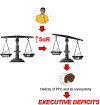Neurobehavioural complications of sleep deprivation: Shedding light on the emerging role of neuroactive steroids
- PMID: 31505075
- PMCID: PMC6982588
- DOI: 10.1111/jne.12792
Neurobehavioural complications of sleep deprivation: Shedding light on the emerging role of neuroactive steroids
Abstract
Sleep deprivation (SD) is associated with a broad spectrum of cognitive and behavioural complications, including emotional lability and enhanced stress reactivity, as well as deficits in executive functions, decision making and impulse control. These impairments, which have profound negative consequences on the health and productivity of many individuals, reflect alterations of the prefrontal cortex (PFC) and its connectivity with subcortical regions. However, the molecular underpinnings of these alterations remain elusive. Our group and others have begun examining how the neurobehavioural outcomes of SD may be influenced by neuroactive steroids, a family of molecules deeply implicated in sleep regulation and the stress response. These studies have revealed that, similar to other stressors, acute SD leads to increased synthesis of the neurosteroid allopregnanolone in the PFC. Whereas this up-regulation is likely aimed at counterbalancing the detrimental impact of oxidative stress induced by SD, the increase in prefrontal allopregnanolone levels contributes to deficits in sensorimotor gating and impulse control, signalling a functional impairment of PFC. This scenario suggests that the synthesis of neuroactive steroids during acute SD may be enacted as a neuroprotective response in the PFC; however, such compensation may in turn set off neurobehavioural complications by interfering with the corticolimbic connections responsible for executive functions and emotional regulation.
Keywords: allopregnanolone; neurosteroids; prefrontal cortex; sleep deprivation.
© 2019 British Society for Neuroendocrinology.
Figures


Similar articles
-
The Neurosteroidogenic Enzyme 5α-Reductase Mediates Psychotic-Like Complications of Sleep Deprivation.Neuropsychopharmacology. 2017 Oct;42(11):2196-2205. doi: 10.1038/npp.2017.13. Epub 2017 Feb 15. Neuropsychopharmacology. 2017. PMID: 28102229 Free PMC article.
-
Allopregnanolone mediates the exacerbation of Tourette-like responses by acute stress in mouse models.Sci Rep. 2017 Jun 13;7(1):3348. doi: 10.1038/s41598-017-03649-1. Sci Rep. 2017. PMID: 28611376 Free PMC article.
-
The neurosteroid allopregnanolone is reduced in prefrontal cortex in Alzheimer's disease.Biol Psychiatry. 2006 Dec 15;60(12):1287-94. doi: 10.1016/j.biopsych.2006.06.017. Epub 2006 Sep 25. Biol Psychiatry. 2006. PMID: 16997284
-
Neurosteroids in the fetus and neonate: potential protective role in compromised pregnancies.Neurochem Int. 2008 Mar-Apr;52(4-5):602-10. doi: 10.1016/j.neuint.2007.07.018. Epub 2007 Aug 2. Neurochem Int. 2008. PMID: 17850922 Review.
-
Sex differences in sleep and sleep loss-induced cognitive deficits: The influence of gonadal hormones.Horm Behav. 2019 Feb;108:50-61. doi: 10.1016/j.yhbeh.2018.12.013. Epub 2019 Jan 15. Horm Behav. 2019. PMID: 30597139 Review.
Cited by
-
Resilience to acute sleep deprivation is associated with attenuation of hippocampal mediated learning impairment.Aging Pathobiol Ther. 2020;2(4):195-202. doi: 10.31491/apt.2020.12.040. Aging Pathobiol Ther. 2020. PMID: 35083449 Free PMC article.
-
Gallic Acid Ameliorates Cognitive Impairment Caused by Sleep Deprivation through Antioxidant Effect.Exp Neurobiol. 2023 Aug 31;32(4):285-301. doi: 10.5607/en23015. Exp Neurobiol. 2023. PMID: 37749929 Free PMC article.
-
Allopregnanolone and depression and anxiety symptoms across the peripartum: an exploratory study.Arch Womens Ment Health. 2022 Apr;25(2):521-526. doi: 10.1007/s00737-021-01186-5. Epub 2021 Oct 29. Arch Womens Ment Health. 2022. PMID: 34714413 Free PMC article.
-
X-linked ichthyosis: New insights into a multi-system disorder.Skin Health Dis. 2022 Oct 17;2(4):e179. doi: 10.1002/ski2.179. eCollection 2022 Dec. Skin Health Dis. 2022. PMID: 36479267 Free PMC article. Review.
-
Preoptic Area Modulation of Arousal in Natural and Drug Induced Unconscious States.Front Neurosci. 2021 Feb 12;15:644330. doi: 10.3389/fnins.2021.644330. eCollection 2021. Front Neurosci. 2021. PMID: 33642991 Free PMC article. Review.
References
-
- Hirshkowitz M, Whiton K, Albert SM, et al. National Sleep Foundation’s updated sleep duration recommendations: final report. Sleep Health. 2015;1:233–243. - PubMed
-
- National Center for Health Statistics. QuickStats: Percentage of Adults Who Reported an Average of ≤6 Hours of Sleep per 24-Hour Period, by Sex and Age Group—United States, 1985 and 2004. JAMA. 2005;294:2692–2692.
-
- Brown WD. Insomnia: Prevalence and Daytime Consequences In: Sleep: A Comprehensive Handbook. John Wiley & Sons, Ltd, 2005; pp. 91–98.
Publication types
MeSH terms
Substances
Grants and funding
LinkOut - more resources
Full Text Sources
Miscellaneous

